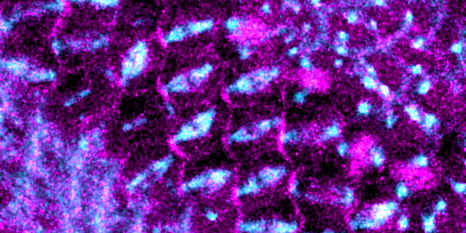
In a new study published July 7, 2022 in eLife, Adam Martin’s lab at the MIT Department of Biology identified the mechanical forces and molecular cues that help the spindles in cells located in the portion of the embryo destined to become the fly’s head to assume the same orientation.
Raleigh McElvery
July 7, 2022
Raleigh McElvery
During development, virtually all multicellular creatures must build themselves up from a ball of cells to a multilayered, fully-functioning organism. In the case of a fruit fly embryo, in order go from blob to organism, the cells must coordinate their divisions along the same axis to drive tissue growth in a specific direction — eventually going on to form the three germ layers known as the endoderm, ectoderm, and mesoderm.
Scientists have long studied how cells orient themselves to divide in a specific direction. It’s clear that this orientation is determined by a bundle of tiny fibers inside the cell called the spindle, which helps segregate the chromosomes so they can be distributed between the two daughter cells as the parent cell splits. When the spindles in neighboring cells are parallel with one another, then the cells will divide along the same axis.
In a new study published in eLife on July 7, 2022, Adam Martin’s lab at the MIT Department of Biology identified the mechanical forces and molecular cues that help the spindles in cells located in the portion of the embryo destined to become the fly’s head to assume the same orientation.
According to Martin, an associate professor of biology and the study’s senior author, his lab was among a handful of labs to take interest in this coordinated spindle orientation in the early fruit fly embryo — and identified the molecular, mechanical, and molecular cues that orient the spindle in a living organism.
“Cell divisions in the fly embryo was thought to be regulated independently of cell shape changes and morphogenetic movements,” Martin says. “However, we found that forces associated with cell invagination actually oriented cell divisions through a novel mechanism that we describe.” First author Jaclyn Camuglia, he explains, spearheaded the project from start to finish.
Prior to Camuglia’s work, researchers knew that spindle orientation was controlled by a complex of multiple proteins, including one protein in fruit flies called Pins (known as LGN in vertebrates). The entire protein complex, including Pins, is coupled to motor proteins that help to rotate the spindle. However, it was still unclear what mechanical forces were orienting Pins to dictate spindle rotation.
“It’s a very striking phenomenon when you look into the microscope at a fly embryo and see all the spindles orienting together,” Camuglia says. “We wanted to know: How are these spindles oriented and why is that directionality important?”
The fly is an ideal organism for probing cell division, because it has a very consistent and predictable cell cycle. During development, cells divide a set number of times, pause briefly, and then start up again in very discrete pockets across the embryo. The researchers wanted to know how the cells in a subset of those pockets in the fly’s head were coordinating their divisions.
Camuglia found that, in healthy embryos, Pins was always recruited to the end of the cell along the anterior-posterior axis (from the fly’s head to rear). By cutting the embryo with a laser, treating it with chemical inhibitors, disrupting the connections between cells, and depleting certain transcription factor proteins, she was able to characterize the mechanical forces that directed Pins to the anterior-posterior axis and thus rotated the spindle in the proper direction. As it turns out, these forces stem from other large-scale tissue movements that occur at the same time to force the embryo to fold in on itself and eventually form the fly’s muscles.
The researchers don’t yet know the role that these coordinated divisions along the anterior-posterior axis play in the developing fruit fly head — or what might happen during development if the divisions were to go awry. But Martin and Camuglia suspect this process facilitates tissue elongation, and helps compensate for any cells that are lost from the tissue during the division process as the embryo folds in on itself.
“This study is unique because it connects mechanical forces to the specific molecular cues like Pins that coordinate cell division,” Camuglia explains. “The factors that shape a developing embryo are critical to understand, because all organisms — from fruit flies to humans — experience these driving forces.” This intersection between physics and biology, she says, is what makes the study so exciting.”
Video: Groups of cells divide in a coordinated and oriented manner in the fruit fly embryo.
Top Image: Enrichment of cortical cues at one end of the cell coordinates the orientation of the mitotic spindle. Credit: Jaclyn Camuglia
Citation:
“Morphogenetic forces planar polarize LGN/Pins in the embryonic head during Drosophila gastrulation”
eLife, online 07/07/2022, DOI: https://doi.org/10.7554/eLife.78779
Jaclyn Camuglia, Soline Chanet, and Adam C Martin
